Hong-Bae Jeon
Measurement-based Close-in Path Loss Modeling with Diffraction for Rural Long-distance Communications
May 02, 2023Abstract:In this letter, we investigate rural large-scale path loss models based on the measurements in a central area of South Korea (rural area) in spring. In particular, we develop new close-in (CI) path loss models incorporating a diffraction component. The transmitter used in the measurement system is located on a hill and utilizes omnidirectional antennas operating at 1400 and 2250 MHz frequencies. The receiver is also equipped with omnidirectional antennas and measures at positions totaling 3,858 (1,262 positions for LOS and 2,596 positions for NLOS) and 4,957 (1,427 positions for LOS and 3,530 positions for NLOS) for 1400 and 2250 MHz, respectively. This research demonstrates that the newly developed CI path loss models incorporating a diffraction component significantly reduce standard deviations (STD) and are independent of frequency, especially for LOS beyond the first meter of propagation, making them suitable for use with frequencies up to a millimeter-wave.
Free-Space Optical Communications for 6G-enabled Long-Range Wireless Networks: Challenges, Opportunities, and Prototype Validation
Sep 16, 2022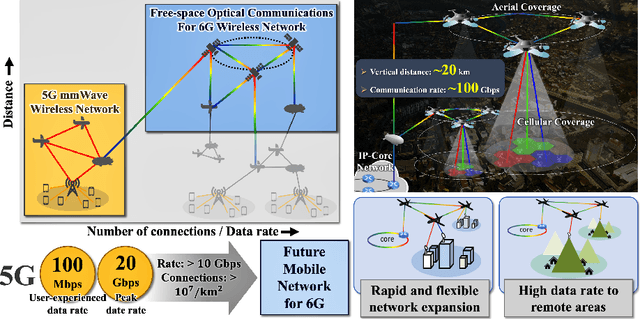
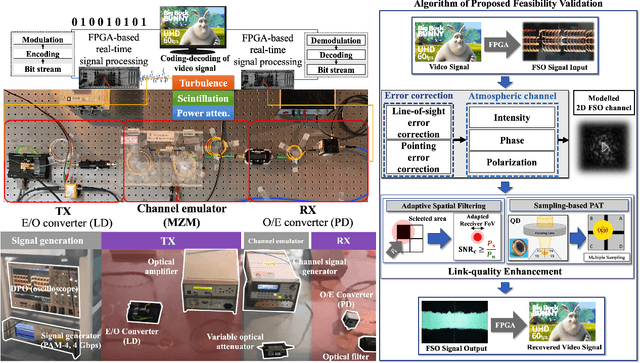
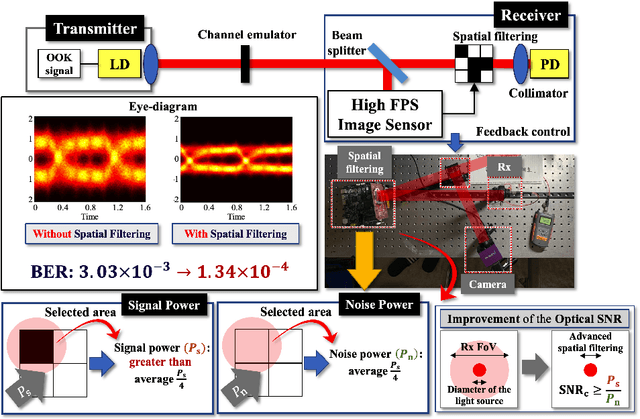
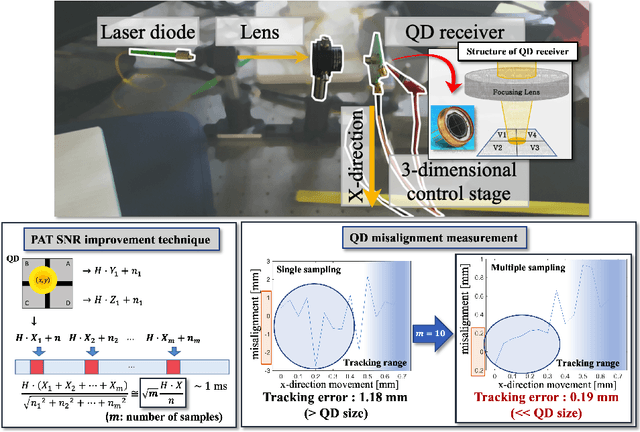
Abstract:Numerous researchers have studied innovations in future sixth-generation (6G) wireless communications. Indeed, a critical issue that has emerged is to contend with society's insatiable demand for high data rates and massive 6G connectivity. Some scholars consider one innovation to be a breakthrough--the application of free-space optical (FSO) communication. Owing to its exceedingly high carrier frequency/bandwidth and the potential of the unlicensed spectrum domain, FSO communication provides an excellent opportunity to develop ultrafast data links that can be applied in a variety of 6G applications, including heterogeneous networks with enormous connectivity and wireless backhauls for cellular systems. In this study, we perform video signal transmissions via an FPGA-based FSO communication prototype to investigate the feasibility of an FSO link with a distance of up to 20~km. We use a channel emulator to reliably model turbulence, scintillation, and power attenuation of the long-range FSO channel. We use the FPGA-based real-time SDR prototype to process the transmitted and received video signals. Our study also presents the channel-generation process of a given long-distance FSO link. To enhance the link quality, we apply spatial selective filtering to suppress the background noise generated by sunlight. To measure the misalignment of the transceiver, we use sampling-based pointing, acquisition, and tracking to compensate for it by improving the signal-to-noise ratio. For the main video signal transmission testbed, we consider various environments by changing the amount of turbulence and wind speed. We demonstrate that the testbed even permits the successful transmission of ultra-high-definition (UHD: 3840 x 2160 resolution) 60 fps videos under severe turbulence and high wind speeds.
RF Lens Antenna Array-Based One-Shot Coarse Pointing for Hybrid RF/FSO Communications
Oct 05, 2021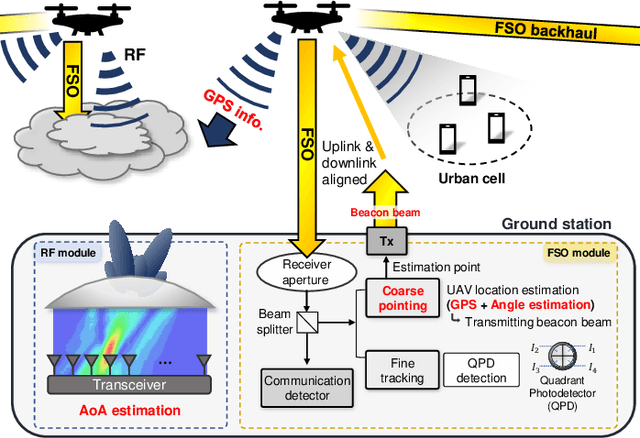
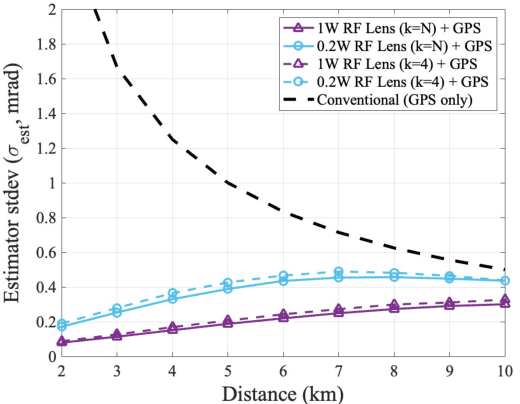
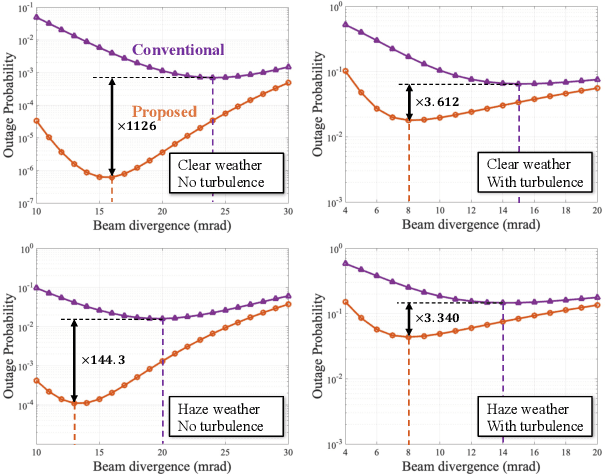
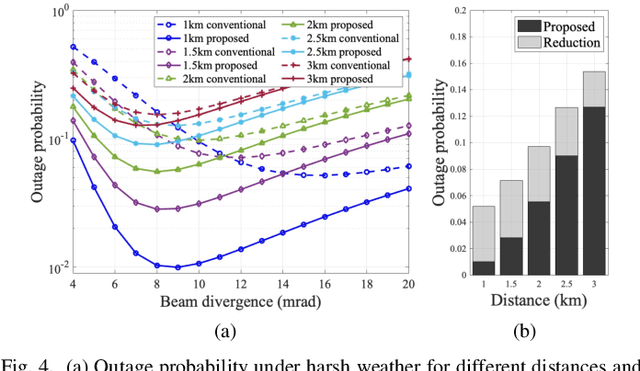
Abstract:Because of its high directivity, free-space optical (FSO) communication offers a number of advantages. It can, however, give rise to major system difficulties concerning alignment between two terminals. During the link-acquisition step (a.k.a. coarse pointing), a ground station can be prevented from acquiring optical links due to pointing errors and insufficient information about unmanned aerial vehicle locations. We propose, in this letter, a radio-frequency (RF) lens antenna array to increase the performance of coarse pointing in hybrid RF/FSO communications. The proposed algorithm using a novel closed-form angle estimator, compared to conventional methods, reduces the minimum outage probability by over a thousand times.
An Energy-efficient Aerial Backhaul System with Reconfigurable Intelligent Surface
Apr 05, 2021



Abstract:In this paper, we propose a novel wireless architecture, mounted on a high-altitude aerial platform, which is enabled by reconfigurable intelligent surface (RIS). By installing RIS on the aerial platform, rich line-of-sight and full-area coverage can be achieved, thereby, overcoming the limitations of the conventional terrestrial RIS. We consider a scenario where a sudden increase in traffic in an urban area triggers authorities to rapidly deploy unmanned-aerial vehicle base stations (UAV- BSs) to serve the ground users. In this scenario, since the direct backhaul link from the ground source can be blocked due to several obstacles from the urban area, we propose reflecting the backhaul signal using aerial-RIS so that it successfully reaches the UAV-BSs. We jointly optimize the placement and array-partition strategies of aerial-RIS and the phases of RIS elements, which leads to an increase in energy-efficiency of every UAV-BS. We show that the complexity of our algorithm can be bounded by the quadratic order, thus implying high computational efficiency. We verify the performance of the proposed algorithm via extensive numerical evaluations and show that our method achieves an outstanding performance in terms of energy-efficiency compared to benchmark schemes.
 Add to Chrome
Add to Chrome Add to Firefox
Add to Firefox Add to Edge
Add to Edge